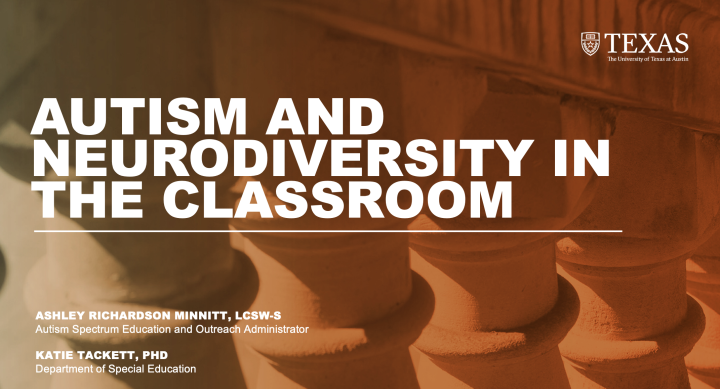
On Oct. 26, Provost’s Teaching Fellow Katie Tackett (Special Education) and Ashley Richardson-Minnitt (Longhorn TIES) facilitated a PTF Think Tank titled Teaching Neurodiverse Students, during which participants discussed neurodiversity and how to support neurodiverse students in classroom environments. Here are a few takeaways from the conversation:
Please note: If you are new to the world of Neurodiversity, you can review Katie and Ashley’s slides for some helpful definitions and contextual information.
You may never know which students in your class are neurodivergent.
Neurodiverse students have wide range of behaviors, strengths, challenges, and needs, and no two neurodivergent students will have the same. Additionally, masking (concealing genuine thoughts, emotions, and/or challenges to better to fit into a neurotypical-oriented environment) is common, especially in women and people of color, so it is impossible to tell who is neurodivergent purely by observing.
Not all students will have formally registered accommodations.
Students may choose not to disclose a diagnosis with you for a variety of reasons, including experiences with and/or perceived social stigma. Additionally, there are many barriers to medical diagnoses for neurodiverse people, so some students may not have a formal diagnosis, or even know that they are neurodivergent. The good news is that there are many steps instructors can take to support a neurodiverse classroom which will ultimately benefit all students, both neurodivergent and neurotypical. The framework of Universal Design for Learning (UDL) provides many possibilities, but here are some things you can do to intentionally keep neurodiversity in mind:
- Ask open-ended questions about students’ unique strengths, challenges, and learning styles. (Examples: “How do you prefer to communicate?” “What do you need to succeed in class?”) These questions could appear in a questionnaire or ungraded quiz at the beginning of the semester, in one-on-one discussions with individuals, or a variety of other avenues.
- Build flexibility into your syllabus to demonstrate different learning modalities.
- Provide clear and direct expectations for course assignments and classroom behaviors, including attendance, deadlines, assignment submission platforms, and other essential course elements.
- Create a safe and encouraging environment for students to discuss accommodations. You can use a syllabus statement, and give clear directions for initiating conversations about accommodations.
- If a student requests, assist in creating structure for unstructured assignments.
- Create clear expectations and processes for group work, including deadlines, potential roles for group members, and processes for troubleshooting group conflicts.
Students might not have experience advocating for accommodations.
Many (but not all) neurodiverse students will have received accommodations in their courses throughout their K-12 education, but individuals may not have fully understood what those accommodations entailed or how they were arranged. As a result, they may not know how best to ask for support, even once they have accommodations registered with Disability and Access.
- If a student is unsure of how to set up a particular accommodation, you can try offering examples from experiences with other students. For example: A student has flexible deadlines as an accommodation, but they do not know how much time to ask for. You could let them know how much flexibility you’ve given past students in this course, e.g. two extra days on assignments, or else notify the instructor if more time is needed and see if that feels right for them.
- There is an addendum that comes with D&A Accommodation letters, designed to help the student and instructor set out specific agreements which they can both use to hold each other accountable. Completing this addendum together makes a concrete, visual expectation for the student (and for you!).
Longhorn TIES provides a variety of neurodiversity resources for students, faculty, and staff.
Longhorn TIES (Transition, Inclusion, Empower, Success) has services for students including consultations, educational programs, and community-building events. They have both free and fee-based student services and can support students in getting fees covered by the Texas Workforce Commission. They also have community events for faculty and staff, provides on-demand workshops and trainings for departments or units, and will consult with instructors on how to best support students.
If you missed this Think Tank and would like to learn more about this topic, contact Longhorn TIES for information and resources. You can also join us for more discussions about teaching and learning at our upcoming PTF Think Tank: Using Art in the Classroom (Nov. 16).

